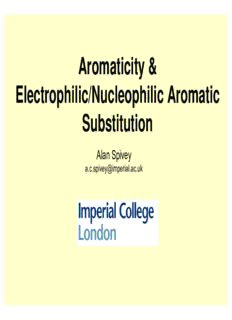
Nucleophilic Aromatic Substitution PDF
Preview Nucleophilic Aromatic Substitution
Aromaticity & Electrophilic/Nucleophilic Aromatic Substitution Alan Spivey [email protected] Format and scope of presentation • Aromaticity: – Historical perspective (Kekulé) – Characteristics, NMR ring currents – Valence bond & molecular orbital representations (Hückel's rule) – Anti-aromaticity • Electrophilic aromatic substitution (S Ar): E – Mechanism (Wheland intermediates, energy profile diagrams & kinetic isotope effects) – Nitration, sulfonylation, halogenation, Friedel-Crafts alkylation and acylation, nitrosation (diazonium salt formation & diazo-coupling, Sandmeyer reactions), – Directing effects (ortho-/para- ratios, ipso-substitution) • Nucleophilic aromatic substitution: – S Ar N – VNS (vicarious nucleophilic substitution) – S 1 & S 1 (Sandmeyer reactions) N RN – Benzyne & arynes Aromaticity: historical perspective • ‘Aromatic’ → ‘aroma’ → natural fragrances e.g. benzaldehyde (peaches) • Unusual stability/unreactivity CO H KMnO4 2 KMnO 4 CO H 2 H3O H O No cf. 3 reaction HCl OH HCl Cl • Late 1800’s: benzene combustion analysis → molecular formula C H 6 6 Ladenburg Dewar Kekulé • No-decolourisation of bromine water (addition of Br across double bonds) 2 Br FeBr 3 Br Br2 Δ C H Br C H Br = 6 5 6 4 2 substitution! three isomers! Br Br Br Br Br Br Kekulé and his dream of snakes... Loschmidt 1861 Kekulé 1861 Kekulé or Loschmidt? • ‘Facts are better than dreams’ Noe & Bader Chem Brit. 1993, 126 • ‘Waking up to the facts?’ Rocke Chem. Brit. 1993, 401 • 'Crocker, Not Armit and Robinson, Begat the Six Aromatic Electrons' Rzepa Chem. Rev. 2005, 105, 3436 (DOI) Aromaticity: stability and bond lengths • Quantification of unusual stability: heats of hydrogenation (calorimetry) – see: Vollhardt J. Am. Chem. Soc. 2000, 122, 7819 (DOI) Pd/C-H 2 ΔH° = -120 kJmol-1 N.B. 1 kcal = 4.18 kJ Pd/C-H 2 ΔH° = -232 kJmol-1 i.e. resonance 'worth' ~8 kJmol-1 [(2x120)-232] Pd/C-H 2 -1 -1 ΔH° = -208 kJmol i.e. aromatic stabilisation 'worth' ~152 kJmol [T(cid:199), P(cid:199)] [(3x120)-208] • X-ray data show all bond lengths to be the same – 1.39Å cf. ave C-C 1.54Å & ave C=C 1.34Å Aromaticity: NMR ring currents • Protons ‘outside’ ring experience deshielding (i.e → low field) • Protons ‘inside’ ring experience shielding (i.e. → high field) • BUT: Schleyer Org. Lett. 2003, 5, 605 (DOI) ‘...there is no evidence for a special ring current influence’ • Zanasi Org. Lett. 2004, 6, 2265 (DOI) '...conventional interpretation...supported by large basis set QM calcs' Aromaticity: NMR ring currents • Benzene gives a singlet at δ7.27 ppm – i.e. deshielding due to ring current (cf. δ 4.5-6.5 ppm for ave. vinylic protons) – i.e. singlet because all H’s are in identical environment (C symmetry) 6 • Higher aromatic systems have stronger ring currents resulting in dramatic shielding/deshielding: H H H H H H H H H H H H H H H H H H H Me Me H H H H H H H H H H H H H H H H H H H 18-annulene Vogel's hydrocarbon dimethyldihydropyrene (18π electrons) (10π electrons) (14π electrons) δ -1.8 ppm inside δ -0.7 ppm inside δ -5.5 (Me) inside δ 8.9 ppm outside δ 7.1 ppm outside Benzene – Valence Bond and Molecular Orbital Representations of Aromaticity • VALENCE BOND (VB) THEORY • resonance hybrids - imaginary structures which differ only in position of electrons (atoms/nuclei do not move) • Not all resonance structures contribute equally - ‘real’ structure is weighted average of resonance structures VB structure • MOLECULAR ORBITAL (MO) THEORY • Linear Combination of Atomic Orbitals (LCAO) • σ-bonding framework formed from sp2 hybridised carbons MO structure • leaves p-orbital on each C atom orthogonal to ring • 6 atomic p-orbitals (AOs) → [LCAO maths] → 6 MOs • each MO capable of containing 2 electrons • 6 electrons available to occupy the 6 MOs • placed in 3 molecular orbitals of lowest energy: bonding orbitals • 3 anti-bonding orbitals remain vacant Benzene - Molecular Orbital Description • Molecular orbital theory rationalises reactions and properties of benzene: DEGENERATE Musulin-Frost diagrams: MO diagrams without the maths • Graphical device for constructing MO energy diagrams: – Frost & Musulin J. Chem. Phys. 1953, 21, 572 (DOI) & Zimmerman J. Am. Chem. Soc. 1966, 88, 1564 (DOI) – Draw appropriate regular polygon within a circle (with atoms touching circumference) – Ensure one atom is at lowest point → ring atom positions represent energy levels – Centre of circle is zero energy level (i.e. bonding orbitals below, anti-bonding above) E 0 cyclopropenyl cyclobutadienyl cyclopentadienyl benzene cycloheptatrienyl cyclooctatetraenyl cation dication anion (tropylium) dianion cation 2 π e's 2 π e's 6 π e's 6 π e's 6 π e's 10 π e's
Description: